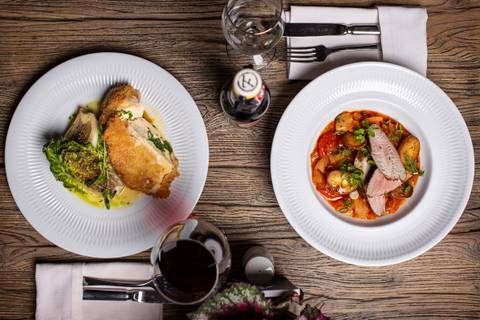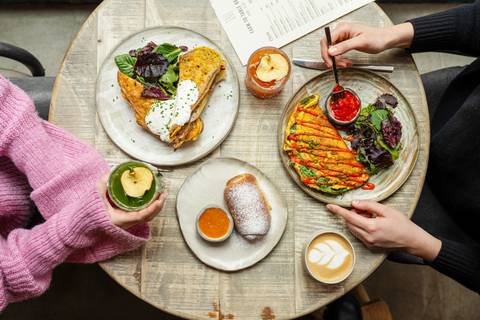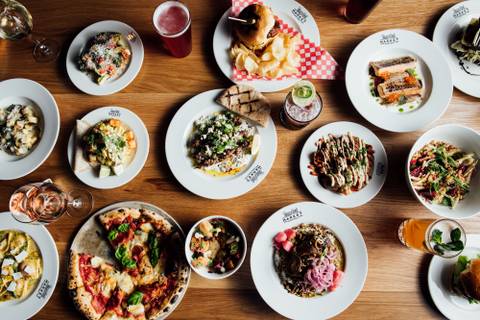Just opposite Nyugati station, Nebuta cooks up traditional Japanese soups and breaded meat, showing that the country’s gastronomy goes way beyond the now familiar sushi.
Unveiled at a busy crossroads amid all the hubbub of the festive season, Nebuta is the younger sister of Kobuta, where the same owners host culinary evenings that explore the whole range of Japanese gastronomy.
Nebuta, meanwhile, focuses on two favourites from the Far East in particular: ramen and katsu breaded meat, supported by bite-sized appetisers and gyoza. Japan’s cuisine draws heavily on the culinary traditions of other countries – as one of the greatest conquerors of the region, they took home the dishes of the territories they occupied, before adapting them with Japanese precision.
Whenever and wherever they discovered soup is still a subject of great debate but the fact is that ramen has long been part of everyday life, as popular as sushi. Katsu, grandma’s Sunday favourite, is currently conquering the world.
Nebuta's concept is simple: quality ingredients, a small selection and quick service bring visitors closer to Japanese gastronomy. Even if a Japanese tourist group accidentally wanders in, they should also be happy with what they find on their plate.
As befitting Japanese fast food, the interior is bright and clean, complemented by a glass wall overlooking Nyugati tér. Orders are taken at the counter, your dishes brought to your table when ready. While you wait, you can gaze at kitchen activity through a large window. Although Nebuta’s speedy service and quick turnover suggest fast food, such is the type of cuisine that preparation is lengthy. Dishes are first created at Kobuta before the finishing touches are added at Nebuta.
The menu is simple, short, though confusing at first because of the Japanese names. Semi à la carte is available – appetisers and desserts are separate, but you can order the main dishes in combination with them. The emphasis is on ramen and katsu, in eight different varieties, so returning customers shouldn’t be bored.
On the appetiser front, there are three options: shiitake mushrooms (690 HUF), mini aubergine miso sauce (990 HUF) or gyoza, such as mangalica pork (890 HUF). These are first roasted then steamed, then roasted again before serving, so that the result is crunchy on the outside and juicy within. The other two appetisers are more an amuse-bouche – the mushrooms act as the ideal preface for more pronounced flavours thanks to the soy sauce that accompanies them.
Of the aforementioned ramen, the four types on the menu are available in two sizes. The big ramen are both the cheapest (2,980 HUF) and most expensive (3,190 HUF), in chicken, duck, pork and vegetable varieties, with salt, soy sauce or miso seasoning. For fried meat, there is also a choice of side dish, cabbage salad, miso soup or rice coming with each portion. Bereg chicken (2,990 HUF) and pork tenderloin (4,690 HUF) both feature, along the original ton katsu (3,290 HUF), a version of long shank. There are also combinations, set menus, which include a little of everything.
The Nebuta set involves a small bowl of ramen and a half portion of katsu, while the lighter kokeshi option comprises a small ramen and five gyoza. From the former, we went for the ramen mixed with dashi stock: the clear, soothing, hot broth was rich in homemade noodles and tossed with bacon and a boiled egg. Although the soup does not seem substantial, it does the job thanks to its generous ingredients guesstimated by hand. From the katsu section, we chose the chicken (3,090 HUF as part of a set) and the difference between simple Hungarian deep-fried meat and the Japanese technique was immediately obvious. The meat is first cooked sous-vide and then twice coated with breadcrumbs – the result is a solid, crisp, golden wrapping around super juicy meat.
In addition to ramen and katsu, there’s an adapted Japanese dish on the menu, namely curry. Unlike its Indian or Thai counterparts, the Japanese version in less in-your-face, less fiery, and is served not with rice but with noodles similar to ramen. The result is a warming, vaguely spicy pasta dish with thick sauce – a real winner when it’s cold – that you can order with chicken (2,390 HUF), mangalica pork (2,590 HUF) or shrimp (3,290 HUF).
After the mains, you can sugar your visit with a floating island dessert (890 HUF), extra creamy and shapely, with a rectangle of soft egg foam swimming on the top, or plum gyoza (890 HUF), filled with sugar-free Beszterce plum jam, slightly sour, a real winter treat.
Nebuta District VI. Nyugati tér
Open: Daily 11am-10pm



